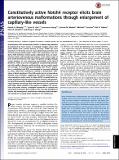| dc.contributor.author | Kim, Tyson N. | |
| dc.contributor.author | Huang, Lawrence | |
| dc.contributor.author | Nielsen, Corinne M. | |
| dc.contributor.author | Lawton, Michael T. | |
| dc.contributor.author | Adams, Ralf H. | |
| dc.contributor.author | Schaffer, Chris B. | |
| dc.contributor.author | Wang, Rong A. | |
| dc.contributor.author | Murphy, Patrick Andries | |
| dc.date.accessioned | 2015-06-15T18:45:41Z | |
| dc.date.available | 2015-06-15T18:45:41Z | |
| dc.date.issued | 2014-12 | |
| dc.date.submitted | 2014-08 | |
| dc.identifier.issn | 0027-8424 | |
| dc.identifier.issn | 1091-6490 | |
| dc.identifier.uri | http://hdl.handle.net/1721.1/97434 | |
| dc.description.abstract | Arteriovenous (AV) malformation (AVM) is a devastating condition characterized by focal lesions of enlarged, tangled vessels that shunt blood from arteries directly to veins. AVMs can form anywhere in the body and can cause debilitating ischemia and life-threatening hemorrhagic stroke. The mechanisms that underlie AVM formation remain poorly understood. Here, we examined the cellular and hemodynamic changes at the earliest stages of brain AVM formation by time-lapse two-photon imaging through cranial windows of mice expressing constitutively active Notch4 (Notch4*). AVMs arose from enlargement of preexisting microvessels with capillary diameter and blood flow and no smooth muscle cell coverage. AV shunting began promptly after Notch4* expression in endothelial cells (ECs), accompanied by increased individual EC areas, rather than increased EC number or proliferation. Alterations in Notch signaling in ECs of all vessels, but not arteries alone, affected AVM formation, suggesting that Notch functions in the microvasculature and/or veins to induce AVM. Increased Notch signaling interfered with the normal biological control of hemodynamics, permitting a positive feedback loop of increasing blood flow and vessel diameter and driving focal AVM growth from AV connections with higher blood velocity at the expense of adjacent AV connections with lower velocity. Endothelial expression of constitutively active Notch1 also led to brain AVMs in mice. Our data shed light on cellular and hemodynamic mechanisms underlying AVM pathogenesis elicited by increased Notch signaling in the endothelium. | en_US |
| dc.description.sponsorship | American Heart Association (Grant 0715062Y) | en_US |
| dc.description.sponsorship | Tobacco-Related Disease Research Program (Predoctoral Fellowship 18DT-0009) | en_US |
| dc.language.iso | en_US | |
| dc.publisher | National Academy of Sciences (U.S.) | en_US |
| dc.relation.isversionof | http://dx.doi.org/10.1073/pnas.1415316111 | en_US |
| dc.rights | Article is made available in accordance with the publisher's policy and may be subject to US copyright law. Please refer to the publisher's site for terms of use. | en_US |
| dc.source | National Academy of Sciences (U.S.) | en_US |
| dc.title | Constitutively active Notch4 receptor elicits brain arteriovenous malformations through enlargement of capillary-like vessels | en_US |
| dc.type | Article | en_US |
| dc.identifier.citation | Murphy, Patrick A., Tyson N. Kim, Lawrence Huang, Corinne M. Nielsen, Michael T. Lawton, Ralf H. Adams, Chris B. Schaffer, and Rong A. Wang. “Constitutively Active Notch4 Receptor Elicits Brain Arteriovenous Malformations through Enlargement of Capillary-Like Vessels.” Proceedings of the National Academy of Sciences 111, no. 50 (December 2, 2014): 18007–18012. | en_US |
| dc.contributor.department | Koch Institute for Integrative Cancer Research at MIT | en_US |
| dc.contributor.mitauthor | Murphy, Patrick Andries | en_US |
| dc.relation.journal | Proceedings of the National Academy of Sciences | en_US |
| dc.eprint.version | Final published version | en_US |
| dc.type.uri | http://purl.org/eprint/type/JournalArticle | en_US |
| eprint.status | http://purl.org/eprint/status/PeerReviewed | en_US |
| dspace.orderedauthors | Murphy, Patrick A.; Kim, Tyson N.; Huang, Lawrence; Nielsen, Corinne M.; Lawton, Michael T.; Adams, Ralf H.; Schaffer, Chris B.; Wang, Rong A. | en_US |
| mit.license | PUBLISHER_POLICY | en_US |
| mit.metadata.status | Complete | |
